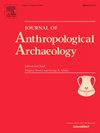维京时代斯堪的纳维亚半岛的战士制度和军事网络
IF 2.2
1区 社会学
Q1 ANTHROPOLOGY
引用次数: 0
摘要
战士的形象在学术和大众对维京时代的描述中都占有重要地位。尽管如此,这一时期的武术文化和生活方式的许多方面仍然不为人所知。为了解决这个问题,本文对维京时代斯堪的纳维亚战士群体的身份、角色和社会地位进行了探索。我们采用了一种最近发展起来的制度方法来研究考古记录,这使我们能够针对和分析一些关键属性,这些属性可以揭示这些群体的目标、活动和意识形态。在此过程中,我们动员并结合了一系列来自考古和文本来源的证据类型,这些证据类型共同有可能提供对战士制度及其在构成史前社会的更广泛社会形态中的地位的更全面的理解。我们的分析揭示了复杂的义务和依赖网络,不仅将这些机构联系在一起,而且影响和塑造了它们与社区互动的方式。本文章由计算机程序翻译,如有差异,请以英文原文为准。
Warrior institutions and martial networks in Viking-Age Scandinavia
The figure of the warrior occupies a key position in both scholarly and popular representations of the Viking Age. Despite this, many aspects of martial culture and lifeways during the period remain obscure. In order to address this issue, this article offers an exploration of the identities, roles, and social position of warrior groups in Viking-Age Scandinavia. We adopt a recently developed institutional approach for the study of the archaeological record, which allows us to target and analyse a number of key properties that shed light on the objectives, activities, and ideologies of these groups. In doing so, we mobilise and combine a range of evidence types, deriving from both archaeological and textual sources, which collectively have the potential to provide a more holistic understanding of warrior institutions and their place within the wider social formations that constituted prehistoric society. Our analysis reveals the complex networks of obligation and dependency that not only bound these institutions together, but which also influenced and shaped the ways in which they interacted with their communities.
求助全文
通过发布文献求助,成功后即可免费获取论文全文。
去求助
来源期刊

Journal of Anthropological Archaeology
Multiple-
CiteScore
4.00
自引率
11.10%
发文量
64
期刊介绍:
An innovative, international publication, the Journal of Anthropological Archaeology is devoted to the development of theory and, in a broad sense, methodology for the systematic and rigorous understanding of the organization, operation, and evolution of human societies. The discipline served by the journal is characterized by its goals and approach, not by geographical or temporal bounds. The data utilized or treated range from the earliest archaeological evidence for the emergence of human culture to historically documented societies and the contemporary observations of the ethnographer, ethnoarchaeologist, sociologist, or geographer. These subjects appear in the journal as examples of cultural organization, operation, and evolution, not as specific historical phenomena.
 求助内容:
求助内容: 应助结果提醒方式:
应助结果提醒方式:


